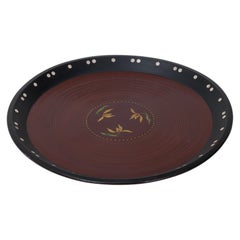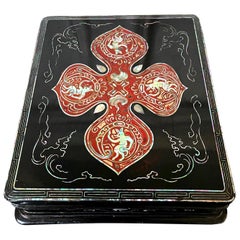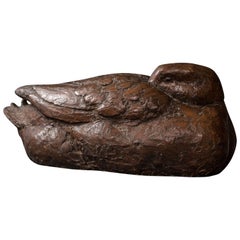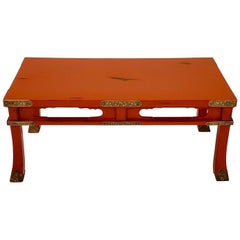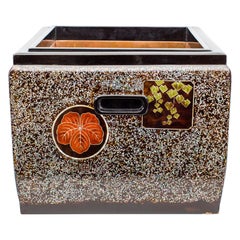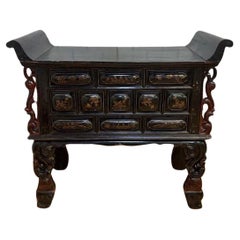Asian Lacquer
to
41
357
137
547
5
3
9
4
2
82
288
177
8
97
45
10
7
1
12
7
1
3
3
3
427
238
113
46
35
555
488
288
195
42
555
551
554
3
1
1
1
1
Place of Origin: Asian
Japanese Lacquer Tray with Intricate Designs
Located in Hudson, NY
This lacquer tray uses several lacquer techniques including multi-color painting of flowers, ito-me (thread pattern) and shell inlay. The artist was Shimano Sanshu (1877 - 1965). He ...
Category
Early 20th Century Showa Asian Lacquer
Materials
Lacquer
Unusual Japanese Lacquer Inkstone Box with MOP Inlays
Located in Atlanta, GA
A Japanese black lacquer box with mother of pearl inlays circa early 20th century, end of Meiji period. It was likely to be used to store inkstone or other scholarly items. The piece displays several interesting characteristics that appear puzzling initially. First, the form is not typical Japanese, but more Chinese and Korean, with its scalloped base. Second, the decoration of MOP inlays also suggests a Korean and Chinese affiliation, especially with the linear borders and the scrolling cloud patters on the sides of the box. These two observations suggest that the box may be from Ryukyu Island instead of Japanese mainland. Third, strikingly in the center of the cover, a bold quarterly floral pattern outlined with MOP was filled with a striking mottled red lacquer using tsugaru nuri...
Category
Early 20th Century Japonisme Asian Lacquer
Materials
Wood, Lacquer
Japanese Showa Period Dry Lacquer Sculpture of a Duck
Located in Hudson, NY
Showa Period (1926 - 1989) sculpture of a duck resting with its head tucked into its wings. Dry lacquer, or kanshitsu, is a process of layering and manipulating lacquer soaked cloth ...
Category
Early 20th Century Showa Asian Lacquer
Materials
Lacquer
18th Century Japanese Altar Table
Located in New York, NY
This lacquered 18th century Edo period altar table was probably made for the private shrine of an aristocratic home. There, it would have been placed before an image of a deity, and ...
Category
Early 18th Century Edo Antique Asian Lacquer
Materials
Brass
Japanese Lacquer Hibachi (Brazier)
Located in Hudson, NY
Japanese Lacquer Hibachi (Brazier), Meiji period (1868 - 1912) Box- shaped Japanese hibachi with mother of pearl inlay, handles on two sides, and a cop...
Category
1880s Meiji Antique Asian Lacquer
Materials
Copper
Antique Chinese Black & Red Lacquered Chinoiserie Altar Storage Chest
Located in Chicago, IL
Antique Chinese Black & Red Lacquered Chinoiserie Altar Storage Chest
Decorate your space with this 19th century Chinese elmwood altar storage chest. Its 10 drawers make it perfect ...
Category
Early 20th Century Qing Asian Lacquer
Materials
Wood, Elm, Lacquer, Paint
Japanese Antique Ewer Lacquer with Bronze Edo to Meiji Period
Located in Atlanta, GA
A Japanese lacquer water ewer without handle (known as hazo in Japanese) that was used to carry water, traditionally together with a large basin (known as tsunodarai) for domestic us...
Category
19th Century Japonisme Antique Asian Lacquer
Materials
Bronze
20th Century Kanshitsu Oke Lacquerware Bowl
Located in Fukuoka, JP
Welcome to our antique lacquerware collection. We are excited to present this stunning Kanshitsu Oke mixing bowl, which dates back to the Showa period of the 20th century. Kanshitsu ...
Category
20th Century Showa Asian Lacquer
Materials
Wood, Lacquer
Early 20th Century Chinese Red Lacquer Decorated Box
Located in San Francisco, CA
Early 20th century Chinese Red Lacquer decorated box. Relief carved top panel of an attendant and scholar. Fine finger joints on the box and lid. Inside top of the lid having Chinese...
Category
Early 20th Century Chinese Export Asian Lacquer
Materials
Wood, Lacquer
Showa Period Lacquer “Flower Basket”
Located in Hudson, NY
The artist calls this vessel a flower basket in the calligraphy on the box. Showa period (1926-1989) black lacquer container in square form with notched c...
Category
1930s Showa Vintage Asian Lacquer
Materials
Lacquer
Antique 20th Century Japanese Mother-of-Pearl Bento Box
Located in LOS ANGELES, CA
Beautiful and antique Japanese Mother-of-Pearl Bento Box with full array of components included. Unique iridescent lacquer finish throughout, with black & gold hand painted details a...
Category
20th Century Other Asian Lacquer
Materials
Mother-of-Pearl
Japanese Meiji Period Carved Root Wood Serving Tray, ca. 1868-1912
Located in New York, NY
DIMENSIONS
Height: 9.25 inches
Width: 11.5 inches
Depth: 10.5 inches
ABOUT MEIJI PERIOD
The Meiji Era was the 44-year period of Japan's history from 1868 to 1912 when the country was under the rule of the great Emperor Mutsuhito. Also called the Meiji Emperor, he was the first ruler of Japan to wield actual political power in centuries.
It was during the Meiji period that Japanese art students first went to Europe to study Western painting, and developed a new style of painting based on these techniques, known as yoga (or ‘Western style’).
Yoga painting...
Category
Late 19th Century Other Antique Asian Lacquer
Materials
Wood
Japanese Black and Gold Lacquer Kushibako
Located in PARIS, FR
Kushibako (comb box) in black lacquer with gold lacquer decoration of arrows and my in the shape of three assembled commas " mitsudomoe " (Okabe; Itakura; Kuki; Hijikata; Arima famil...
Category
Late 19th Century Antique Asian Lacquer
Materials
Lacquer
Extremely Fine and Rare 17th-Century Japanese Export Lacquer and Inlaid Cabinet
Located in Amsterdam, NL
An extremely fine and important Japanese lacquer cabinet with gilt-copper mounts for the European market
Edo period, late 17th century
The pictorial style decorated rectangular...
Category
Late 17th Century Antique Asian Lacquer
Materials
Brass
17th-Century Japanese Namban Lacquer Coffer on French Stand, Possibly by Boulle
By André-Charles Boulle
Located in Amsterdam, NL
An impressive and large Japanese 'Namban' transition-style lacquer coffer with fine gilt copper mounts on a French Re´gence base, possibly by André-Charles Boulle (1642-1732)
Kyoto, 1640-1650, the base 18th century
?The coffer with shaped cartouches on a nashiji ground on the lid, front and sides, with fine decorations in various techniques: takimaki-e (high relief), tsuke-gaki (drawing with narrow lacquer lines and over sprinkling with gold and silver), usuniku-takamei-e (demi relief), kimekomi (pushed inside) and accents of kirigane (small geometrical metal mosaics). Inside the cartouche on the lid a landscape with volcanos...
Category
17th Century Antique Asian Lacquer
Materials
Brass, Ormolu
Recently Viewed
View AllMore Ways To Browse
Large Japanese Lacquer Box
Meiji Japan Tray
Lacquered Japanese Bowl
Japanese Comb
Japanese Lacquered Miniature
Japanese Red Lacquer Tray
Japanese Lacquer Plaque
Large Cinnabar
Chinese Carved Cinnabar Red Lacquer
Korean Mother Of Pearl Furniture
Korean Mother Of Pearl
Japanese Lacquer Ware
Antique Chinese Cinnabar Lacquer
Japanese Lacquered Trunk
Chinese Red Lacquer Tray
Red Lacquer Ware
Burmese Lacquer Trays
Japanese Makie Lacquer
